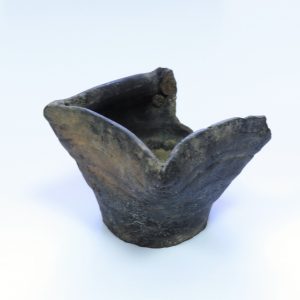Heating and Smoke Channels of Rauna Castle
During the active period of Rauna Castle use, it was heated with stoves. It is evidenced by several smoke channel sites preserved in the walls of the castle, which had been built inside. Fireplaces or stoves were placed in the corners of the premises and were connected to the masonry wall on two sides. Multiple evidence on the use of stoves and fireplaces have been collected during archaeological research, where fragments of glazed tiles have been found and, in one case, the restoration of a stove tile to the condition that demonstrates how it looked in the 17th century was successful. Archaeological research was not performed at the first floor and cellar of the main blocks of the castle, therefore it cannot be stated exactly that the main premises of the second floor of Rauna Castle were heated by using hypocaust heating system typical of Middle Ages. Presumably, such system could have existed, because traces of smoke channels are seen in the walls of the main blocks, which proceed from the cellar to the level of the third floor. The hypocaust system was operated by means of the stove that was built on the utility floor and there was a separate chamber over it, which was filled with boulders. When fire was built in the stove, the boulders heated up and the heat from them, through separate channels, entered the premises built on upper levels and, through hatches in the floors, heated them.
Gallery
Travel objects
- Rauna Castle
- Rauna Castle Courtyard
- Rauna Park and Rauna Manor Estate
- Rauna Evangelic Lutheran Church
- Rauna Agricultural Society House
- Rauna Freedom Monument
- Rauna Mill
- Strads Pub / Rauna Dairy
- Plūme House / Bookshop
- Rauna Parish House
- Rauna Congregation School / Office of Sarkanais Oktobris Collective Farm
- Rauna Devil’s Cave
- Rauna Staburags (Staburags Cliff of Rauna)
- Jānis Cimze Monument
- Rauna “Pārupe” (Left Bank)
- Baižkalns Manor Estate
- Lauktehnika (Agricultural Equipment Station)
- House of Doctor’s Skaidrais Family / House of psychotherapist Jānis Zālītis
- Rauna Hospital
- Rauna Post Office
- Rauna Pastor’s Manor
- The Centre of Rauna and the visit of USSR leader Nikita Khrushchev
- Rauna Cemetery
- Cemetery of Soviet Soldiers, who Died during the World War II
- Rauna Castle Tower
- Intermediate Passages of Rauna Castle
- Rauna Castle Plastering
- Heating and Smoke Channels of Rauna Castle








